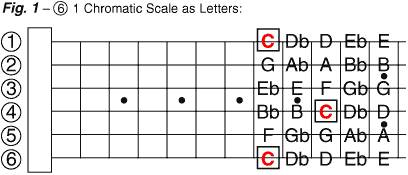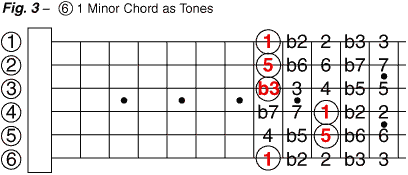Diatonic, Chromatic? It's Greek to Me!
Like many things, Music and the Guitar can be traced to Ancient Greece. For example,
TONOS is Greek for TONE, and means "to stretch" - like TUNING your guitar. In the 6th.
Century B.C., Pythagoras discovered the OCTAVE - by doubling the frequency of the tonic
(2:1 ratio). He also found 7 intervals in-between the octave, and this became known as
the DIATONIC scale. In Greek, "Di" means "two" or "double", and "Dia" means "through"
or "apart". An "Interval" is the distance between two tones. A "Scale" is a series of
step-by-step tones, played one after another. And "Tonic" is the first tone of the scale.
So, the "Diatonic Scale" simply means: "the tones between two tones (tonic and octave)".
Pythagoras also discovered 5 CHROMATIC intervals; the sharps (#) and flats (b). In Greek, "Chroma" means "color". And when these 5 chromatic-color-tones are added to the 7 diatonic tones, the 12 tone "Chromatic Scale" is the result.
By the time of Bach (c1600), "Equal Temperament" (the octave divided into 12 equal parts) had become the accepted standard of tuning and remains so today. In fact, an octave on the guitar is "the same letter, 12 frets apart".
The following is the Chromatic Scale starting on "C", as letters and tones:

Now, from these 12 tones, ALL Music may be "spelled" and then played on the Guitar! Here are a few Chords, Scales and Arpeggios, spelled in tones and letters:

So till next time, grab some olives, feta and a pita, and have some fun, now that you can speak Greek...
Return to Accomplished Lessons
Pythagoras also discovered 5 CHROMATIC intervals; the sharps (#) and flats (b). In Greek, "Chroma" means "color". And when these 5 chromatic-color-tones are added to the 7 diatonic tones, the 12 tone "Chromatic Scale" is the result.
By the time of Bach (c1600), "Equal Temperament" (the octave divided into 12 equal parts) had become the accepted standard of tuning and remains so today. In fact, an octave on the guitar is "the same letter, 12 frets apart".
The following is the Chromatic Scale starting on "C", as letters and tones:
| Letters: (Figure 1) | |||||||||||
| C | Db | D | Eb | E | F | Gb | G | Ab | A | Bb | B |
| Tones: (Figure 2) | |||||||||||
| 1 | b2 | 2 | b3 | 3 | 4 | b5 | 5 | b6 | 6 | b7 | 7 |

Now, from these 12 tones, ALL Music may be "spelled" and then played on the Guitar! Here are a few Chords, Scales and Arpeggios, spelled in tones and letters:
| CHORDS: | |||||||||
| C Minor (Figure 3): | |||||||||
| 1 | b3 | 5 | |||||||
| C | Eb | G | |||||||
| C major seven (Figure 4): | |||||||||
| 1 | 3 | 5 | 7 | ||||||
| C | E | G | B | ||||||
| SCALES: | |||||||||
| C minor pentatonic (Figure 5): | |||||||||
| 1 | b3 | 4 | 5 | b7 | |||||
| C | Eb | F | G | Bb | |||||
| C whole tone (Figure 6): | |||||||||
| 1 | 2 | 3 | b5 | b6 | b7 | ||||
| C | D | E | Gb | Ab | Bb | ||||
| ARPEGGIOS: | |||||||||
| C dominant seven (Figure 7): | |||||||||
| 1 | 3 | 5 | b7 | ||||||
| C | E | G | Bb | ||||||
| C minor seven b5 (Figure 8): | |||||||||
| 1 | b3 | b5 | b7 | ||||||
| C | Eb | Gb | Bb | ||||||

So till next time, grab some olives, feta and a pita, and have some fun, now that you can speak Greek...